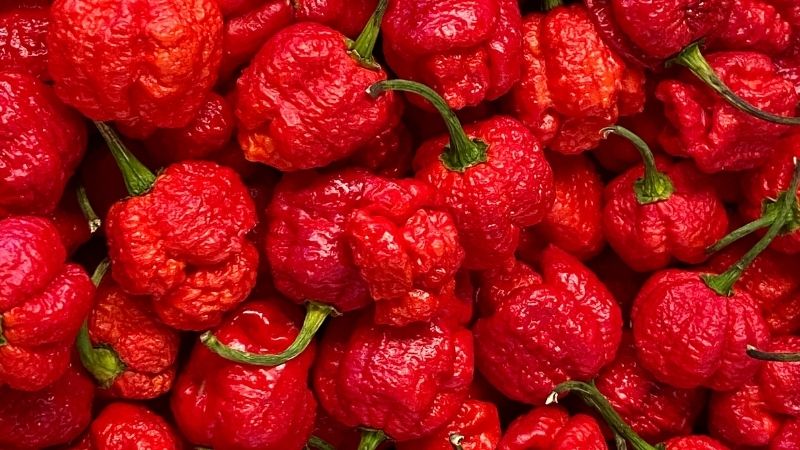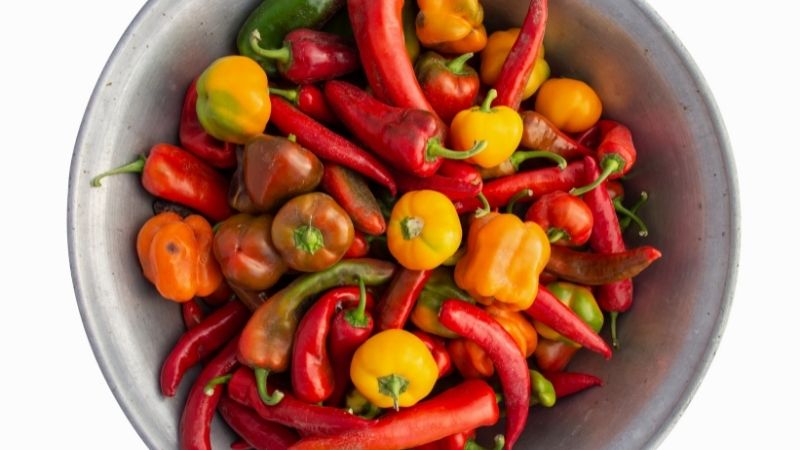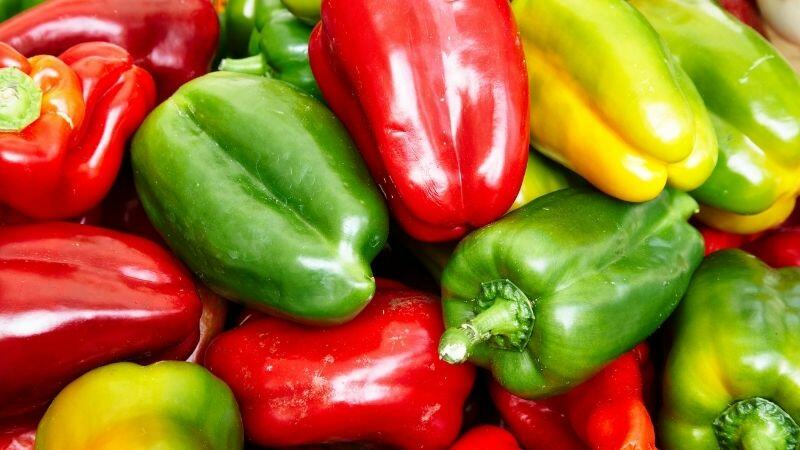Knowing the heat level of pepper is essential if you want to find or make the perfect recipe. But what is an excellent way to tell if a pepper is spicy before biting into it?
Here are some ways to know if a pepper is spicy:
- Its smell can irritate your nose.
- Smaller peppers tend to be spicier.
- Older and wrinkled peppers are spicy.
- The juice of the pepper can irritate your skin.
- The seeds of spicy peppers appear darker.
- Red peppers are usually spicier.
- The tip of the pepper tastes spicy.
While these are not definitive signs that a pepper is spicy, they can help you observe the fruit properly before taking a bite. Further in the article, I will discuss how these signs prove a pepper is spicy, what makes peppers spicy, and the scale that measures the fruits’ spiciness level.
1. Its Smell Can Irritate Your Nose

It may seem silly, but if you are wondering if a pepper is going to be spicy, you can always give it a sniff – from a safe distance, of course! Spicy peppers don’t usually give off a strong spicy scent but sniffing overripe ones may cause some irritation to the mucus membranes in your nose.
Since capsaicin (the chemical that makes peppers spicy) affects nerves in general, your nose will be a good indicator of whether or not the pepper is too spicy for you. If the smell of the pepper stings your nose, you might want to stay away!
2. Smaller Peppers Tend to be Spicier

As a general rule, the smaller the pepper, the hotter the pepper. This rule applies to nearly all peppers, and if you do not want to trust your sense of smell, trust your sense of size. If you are looking for something mild to add to dinner, going big is probably your best bet.
3. Older and Wrinkled Peppers Are Spicy
As hot peppers age, they become more pungent. If you have some peppers that are older than others, you can be pretty sure that the elder will be spicier. Look for tell-tale signs of age, including lines or wrinkles and color changes.
4. The Juice of the Pepper Can Irritate Your Skin
If you cannot completely trust your judgment when it comes to the smell and physical appearance of peppers, you can try to squeeze the pepper between your fingers.
However, you will have to do this with caution as the juice can irritate your skin. Some receptors on your skin will recognize the capsaicin and you will feel the same burning sensation on your fingertips as you would in your mouth when you eat spicy foods.
5. The Seeds of Spicy Peppers Appear Darker

If you have the chance to open up a pepper and you see bright white seeds, chances are you are not holding a very spicy pepper. However, if the seeds of the pepper are grey or brown, you might want to be careful. But again, weigh this evidence against other signs you see before you make a verdict.
6. Red Peppers Are Usually Spicier

In general, the color of the peppers will darken with age, so yellow or green peppers will be milder than red or orange of the same variety. Be sure that you take other factors (such as size and smell) into account though.
Jalapenos are small, spicy peppers that are nearly always green; so do not let color alone determine how spicy a pepper is.
Moreover, while they belong to the same family, bell peppers are not spicy at all, regardless of what color they are.
7. The Tip of The Pepper Tastes Spicy
Yes, the taste is the most obvious way to test how hot a pepper is, but there is actually a way of tasting a pepper without getting the full force of the
Capsaicin is most concentrated near where the seeds in a pepper are located. This means that if you cannot tell how hot a pepper is going to be, you can cut off a part of the flesh that is far from the seeds (such as the tip) and give that a nibble. If the tip of the pepper is too spicy, odds are the rest of the pepper is even worse!
What Makes a Pepper Spicy?
Capsaicin is the chemical that makes a pepper spicy. The amount of capsaicin that the pepper contains determines how spicy the fruit is. Capsaicin is a fascinating chemical that directly affects the nerve endings in our bodies associated with heat.
We usually experience this heat in our tongues and mouths, but sometimes by our eyes if we are unlucky enough. Unfortunately, at one point in time, I was unlucky enough.
Some of the chemical properties of capsaicin technically classify it as a mild poison. If you happen to inject capsaicin straight into your body in a large enough dose, it can cause permanent nerve damage.
However, there is no need to be afraid of causing nerve damage by eating hot or very hot peppers. Permanent, debilitating nerve damage is highly improbable in cases of average consumption.
You are far more likely to do your body good than harm through your digestion of capsaicin. The compound actually awakens the immune system and prepares your body to fight pain. Because the chemical is good at starting an immune response, it is often the main ingredient in pain-killing ointments and therapeutic gels.
Capsaicin is a powerful antimicrobial as well, meaning that it has the ability to kill bacteria. This antimicrobial property made it a very sought-after food preservative in ancient times, as it kept food safe for consumption long after the usual shelf-life.
In summary, the chemical capsaicin makes hot peppers what they are. The chemical is as strange as it is valuable, and next time you cook or eat a meal with spicy peppers, you will be able to know precisely what causes the heat!
Some Common Hot Peppers To Watch Out For
Although there are some physical signs that could help us know if a pepper is spicy or not, some experts have already created a scale to guide people with an accurate measure of spiciness. The relative hotness of each pepper is measured using the common Scoville Heat Scale.
Just in case you do not yet trust your hot pepper spotting abilities, here is a list gathered from Recipe Critique of the most common hot peppers sold in stores. The list is arranged in increasing levels of spiciness.
- Ancho Chili/Poblano pepper. These are relatively mild peppers that are medium to small, thin and long, and green or red in color.
- Chipotle Meco and Chipotle Morita. This variant of peppers is slightly more spicy than the Ancho but not dangerous yet. They are medium to small, short-bodied, and green or red in color.
- Jalapeno pepper. You may have tried this kind of pepper in many Mexican foods. It is much spicier than the Chipotles, jalapenos are nearly always small, narrow-bodied, and green.
- Serrano pepper. This variant is much worse than the jalapeno. It is very small, thin-bodied, and can be green, yellow, orange, or red.
- Cayenne pepper. It is a very painful pepper to encounter. It is very small, thin, and red.
- Habanero’s pepper. This one is far worse than the Cayenne pepper. Use with utmost caution. They are small, plump, and orange or red in color.
While there are many more hot peppers in the world, the ones listed above are used in many spicy dishes and will no doubt find their way into the kitchen of any
Final Words
Hot peppers are fascinating fruits both by the scientific definition and by standard flavor classification. It is well worth the time it takes to learn about them! It is always best to understand heat and
Being caught off guard by the spiciness of a dish will always be an unpleasant surprise, and hopefully, one you are now equipped to avoid.
I hope this article has been informative as you search to understand the hot peppers of the cooking world! Happy cooking and happy dining!
Sources
- Recipe Critique: Learn the Hot Pepper types and Their Heat
- Alimentarium: The Scoville Scale
- Food Beast: What You Should Know About Capsaicin – America’s Favorite Poison
- WebMD: Capsaicin: Health Benefits, Safety Information, Dosage and More
- Simply Recipes: Tip: How to Check for the Hotness of Jalapeños
- National Library of Medicine: Capsaicinoids in the Treatment of Neuropathic Pain: A Review
- Scoville Scale: The Scoville Scale for Chili Peppers





